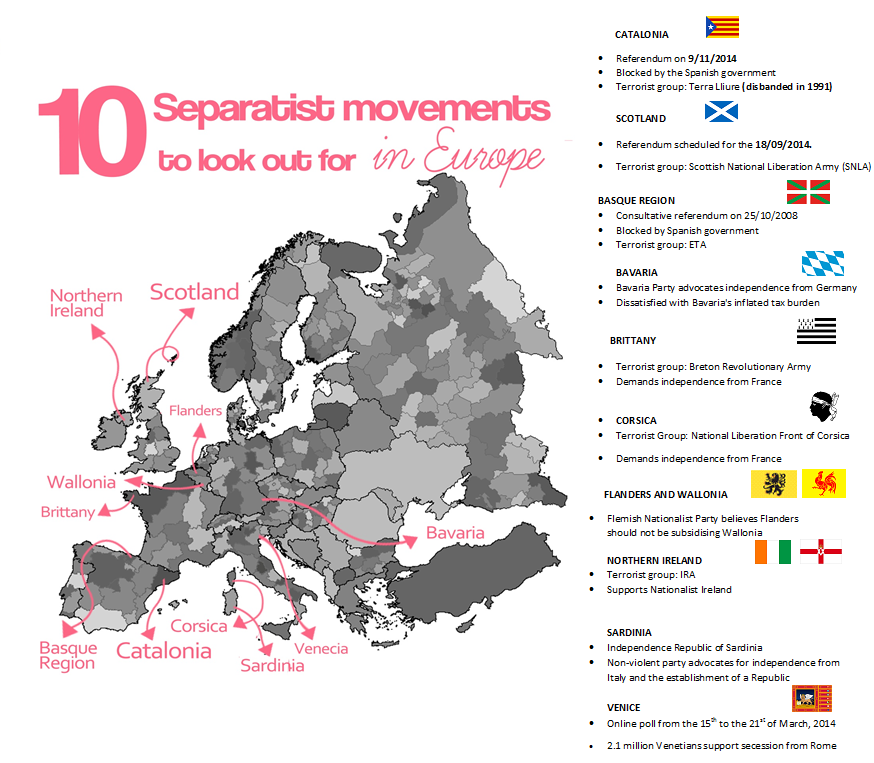
The desire for independence of diverse regions across the globe has instigated widespread controversy and worldwide international media coverage in the course of the present year 2014. This promises to mark a turning point in the history of separatist movements.
Throughout Europe, several territories have risen to challenge the ties which link them to the larger countries to which they are politically and financially attached.
A topical example lies in Crimea’s annexation to the Federal Estate of Russia, on March the 18th 2014. Furthermore, Scotland will be holding a referendum on the 18th of September this year. This will decide its future as part of the United Kingdom.
Another country in the heart of Europe -the Italian province of Venice- carried out a week-long online poll, from the 15th to the 21st of March. The results revealed that a staggering 2.1 million Venetians support a secession from the Vatican city of Rome and the establishment of a Venetian Republic. This is on the grounds that the capital city is draining Venice’s wealth through its poor handling of the country’s financial crisis.
Similarly, in the Spanish region of Catalonia, citizens are forced to contribute an annual total of 17 billion Euros in taxes to the government’s coffers in Madrid, and as Joseph Desquen points out:
“A fully independent Catalonia would not have to pay taxes to Madrid, that are invested elsewhere. Instead, it could invest them to the benefit of Catalonia.”
Ultimately, the refusal on behalf of the capital city to grant a referendum (initially scheduled for the 9th of November this year) has increased tensions between Barcelona and mainland Spain. This has created a bias in reporting, as in order to ensure the media´s complicity in efforts to declare Catalonia an independent state, the Catalan government has adopted a policy of subsidies to financially assist media outlets published in Catalan.
This has also driven newspapers to alter their political agendas to support the movement for independence and benefit from the generous government grants. This is what Spaniards have begun referring to sarcastically as the “business of independence” with claims that the system jeopardizes journalistic integrity by taking advantage of the financial crisis, to ‘buy’ journalists’ political loyalties.
A prime example lies in the case of El Punt Avui Newspapers Group, which receives a million and a half euros a year, with a readership of scarcely 28.000.
Scroll down to view a picture essay of the independence movement in Catalonia.
“Independence and Socialism. Student Union of the Catalan Countries”
Exit to the railway station in Barcelona.
This is the main form of transport in the city, and the first image students take in every morning as they make their way to university.
“We are Catalan countries”
Grafitti found on campus at the Autonomous University of Barcelona.
The star above represents the “Estelada Catalana” nationalist symbol – part of an unofficial flag employed under separatist ideology to express support of the independization of the Catalan Countries.
These include Catalonia, Valencia and Balearic Islands.
Zurbano Sabadell street in Barcelona
Worn out by the high temperatures and the passing of time, independence flags waving in the wind of Catalan balconies have become a common sighting in the streets of urban Barcelona.
A Catalan citizen drives his desire for independence around the city by attaching a nationalist flag to the side of his car.
Catalan independence protest march
11/09/2013
Last year saw the city’s most compelling protest movement to date.
In response to government assertions that Barcelona would not be able to survive as an independent state, demonstrators took to the streets under the slogan “Cataluña has nothing to lose but its chains”.
Human chain for independence
11/09/2013
On this symbolic date 1.6 million citizens joined hands in a mass movement which developed along 400 miles, bordering the whole of Catalonia.
‘Arc de Triomf’ (Triumphal Arch) in Barcelona
National Day of Catalonia, commemorated annually to honour the last defence of Barcelona on September the 11th, 1714.
Protesters chant “Catalonia is NOT Spain.”
Torredembarra village in the outskirts of Catalonia
11/09/2013
Demonstrations in favour of independence took place in rural areas of Barcelona as well as in the city.
Thousands of citizens marched under the scorching sun with the unofficial Catalan flag tied to their backs in superhero fashion.
Floral offerings at the Rafael Casanova monument
11/09/2013
Rafael Casanova was the councillor of Barcelona during the Spanish succession.
Wounded whilst defending the city on September the 11th, 1714, he is considered a national hero.
Catalan politicians and public figures pay him tribute annually on the National Day of Catalonia.
Castells Catalans (Catalan Castles)
Catalan tradition of building and dismantling a human tower.
In 2010, ‘Castells’ were included amongst the ‘Masterpieces of the Oral and Intangible Heritage of Humanity’ by the UNESCO.
On the National Day of Catalonia ‘Castells’ were risen as a symbol to empower the movement for independence.
The post Separatist movements in Europe appeared first on Buzz.









